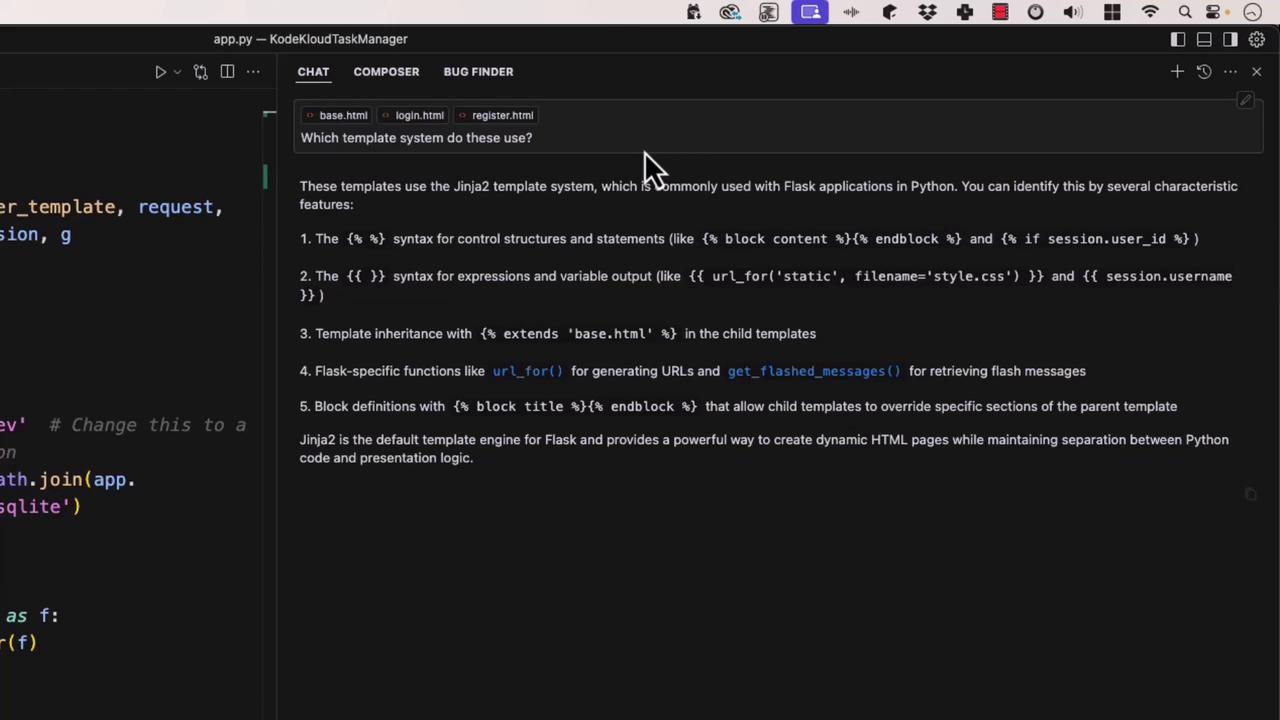Cursor AI
Interacting with your Codebase
Demo Contextual References
In this guide, we’ll explore how to harness Cursor AI’s contextual references to focus on exactly the code you need—whether it’s specific files, functions, or even GitHub pull requests. By including or excluding contexts, you’ll get sharper, more relevant answers for code exploration and review.
1. Adding Context from Your Codebase
You can click Add Context on any file (or even just select particular functions) to include them in your AI session. For example, here’s our app.py:
import csv
import sqlite3
import os
from flask import Flask, render_template, request, redirect, url_for, flash, session, g
from datetime import datetime
import h5lib
import logging
# Initialize Flask app
app = Flask(__name__)
app.config['SECRET_KEY'] = 'dev' # Change this to a random secret key in production
app.config['DATABASE'] = os.path.join(app.instance_path, 'task_manager.sqlite')
# Read CSV utility function
def read_csv(file_path):
with open(file_path, 'r') as f:
reader = csv.reader(f)
for row in reader:
print(row)
# Ensure the instance folder exists
try:
os.makedirs(app.instance_path)
except OSError:
pass
# Basic database connection
def get_db():
if 'db' not in g:
g.db = sqlite3.connect(
app.config['DATABASE'],
detect_types=sqlite3.PARSE_DECLTYPES
)
g.db.row_factory = sqlite3.Row
return g.db
Warning
Never commit sensitive values like SECRET_KEY or database credentials in your production code. Use environment variables or a secrets manager instead.
2. Querying Specific Contexts: Templates & Templating Engines
You can narrow your search to HTML templates and ask, “Which templating system do these use?” The AI will identify Jinja2, Flask’s default engine:

3. Excluding Irrelevant Files
Context exclusion is just as powerful. You can omit JavaScript files, tests, or any directories that aren’t relevant:
| Context Selection | Purpose | Example |
|---|---|---|
Include: app.py | Analyze core Flask application logic | Select get_db() for DB optimizations |
Exclude: tests/ | Remove unit tests from AI consideration | Focus on production code |
Exclude: static/ | Skip frontend assets | Avoid noise from CSS/JS files |
4. Focusing on Individual Functions
To optimize a specific routine, just select the function. For example, a simple password hashing utility:
def hash_password(password):
return hashlib.sha1(password.encode()).hexdigest()
Or isolate the get_db() function to ask for performance improvements. The AI might suggest enabling WAL mode, tuning cache sizes, and using autocommit:
def get_db():
if 'db' not in g:
g.db = sqlite3.connect(
app.config['DATABASE'],
detect_types=sqlite3.PARSE_DECLTYPES,
isolation_level=None, # Autocommit mode
cached_statements=128 # Prepared-statement cache
)
g.db.execute('PRAGMA journal_mode = WAL;') # Write-Ahead Logging
g.db.execute('PRAGMA synchronous = NORMAL;') # Balance durability and I/O
g.db.execute('PRAGMA cache_size = 10000;') # Larger page cache
g.db.execute('PRAGMA temp_store = MEMORY;') # In-memory temp tables
g.db.row_factory = sqlite3.Row
return g.db
Note
Performance tuning PRAGMAs can greatly reduce disk I/O and improve concurrency for SQLite-based applications.
5. Integrating with GitHub Contexts
Cursor can also pull in GitHub data—search commits, PRs, or specific files in a repo. For instance, to review database-layer changes in your pull requests:
from flask import render_template, request, redirect, session, g
import os
import sqlite3
DATABASE = 'database.db' # Change this as needed
def connect_db():
return sqlite3.connect(os.path.join(app.root_path, DATABASE))
with connect_db() as conn:
# ...database logic here...
pass
By mixing and matching contexts—local files, folders, or GitHub references—you guide the AI to focus on exactly what matters. This precision leads to more accurate insights and a streamlined code review process.
Links and References
Watch Video
Watch video content